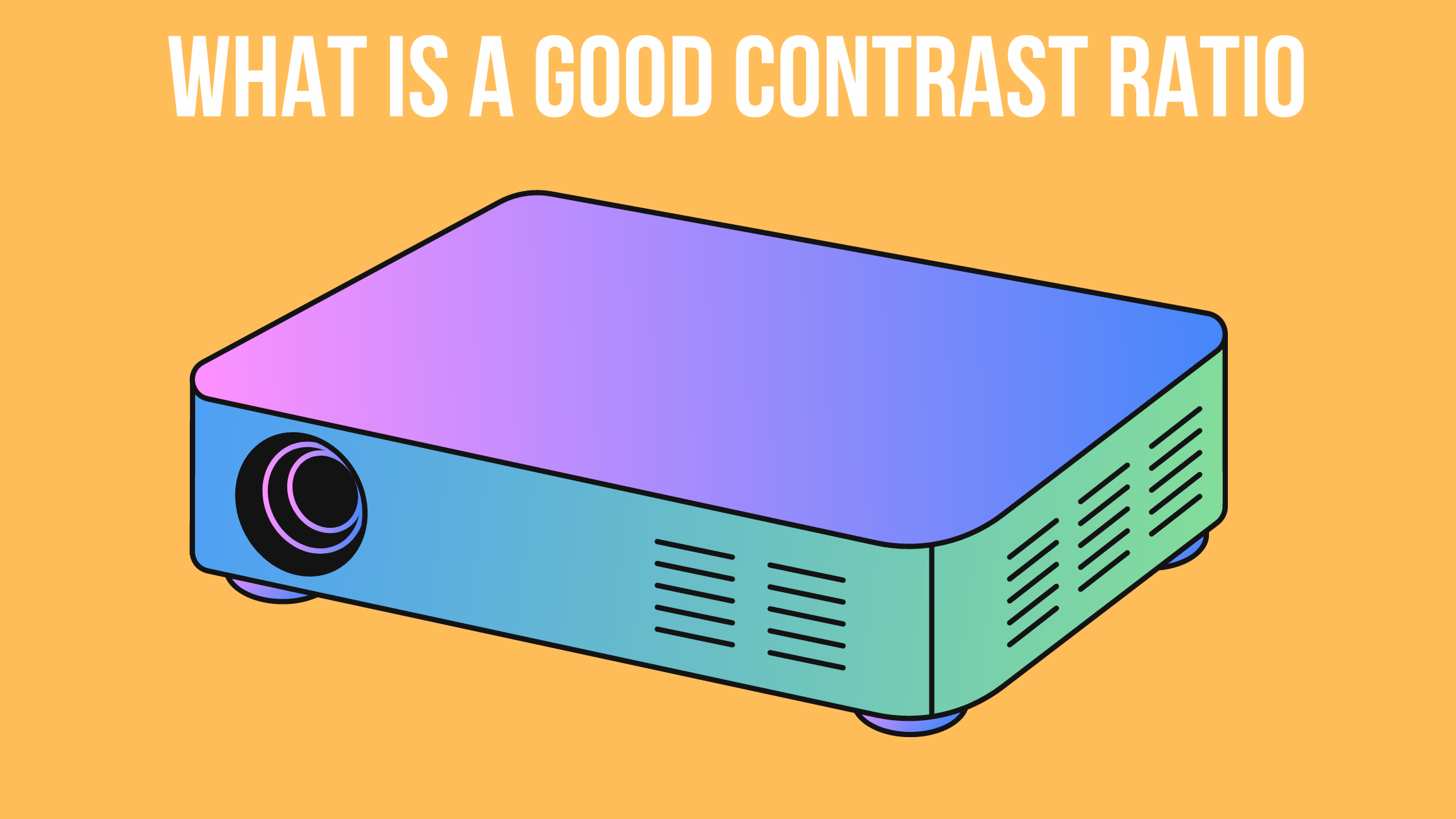The most asked question is what is a good contrast ratio for projectors? In general, the contrast ratio is the light that is reflected from an entirely black and white picture. To put it simply, the most brilliant white in comparison to the deepest blacks will provide a considerably clearer image, bringing out all weak colors and fine details present throughout the image.
It can be expressed as a static or moving contrast ratio. The static contrast ratio is measured by dividing the peak brightness of the screen by its darkest area.

A greater static contrast ratio means blacks appear blacker and whites appear whiter, which leads to a more immersive experience when watching films or playing games. The dynamic contrast ratio is another type of measure that fluctuates with changes in scene lighting. Dynamic contrast ratios typically vary from the 5 to 20 in range and fluctuate based on what is happening on the screen.
Static contrast ratios are essential for designers and videographers who require precise color representation in their work, while dynamic ratios are often more helpful for customers wanting to purchase a TV or projector.
How Do You Calculate the Contrast Ratio?
The contrast ratio of a display is a measure of the difference between the highest and lowest brightness levels of an image. This is significant because it indicates how bright the black and white portions of a picture are in comparison.
You’ll notice that the contrast ratio is usually reported as either a static or dynamic number. The static number gives us an apples-to-apples comparison between different TVs, but it doesn’t account for changes in scene lighting.
The dynamic number accounts for changes in brightness when the TV is displaying a video and can be useful for consumers.
Formula to Calculate the Contrast Ratio
Contrast Ratio = Peak Brightness of the Image / (Largest Brightness of the Dark Areas + Dark Areas)
Difference Between Static and Dynamic Contrast Ratios
A static contrast ratio is the ratio of the brightest and blackest colors in a digital image. This number differentiates between colors.
In contrast, a dynamic contrast ratio changes with changes in scene lighting. This number is usually within the range of 5-20 and can swing from 1,000:1 to 10,000:1. This means that a dark scene has a 10x brighter backlight.
For example, when a dark scene is on screen, the backlight turns on and darkens the screen, but when a bright scene appears on the screen, the backlight is turned off and the bright scene lights the screen.
What is the Best Contrast Ratio?
A projector with a contrast ratio of 1000:1 is considered best. However, to obtain a higher picture quality, the contrast ratio must be higher than 2000:1. For the video displayed in a darkened space, such as films or games, a high contrast ratio is essential for providing an immersive experience.
Most modern projectors have a 2000:1 contrast ratio or more. To get the greatest results, search for projectors with the highest contrast ratio. These numbers will provide the projector’s specifications and indicate the contrast ratio.
It is important to remember that the contrast ratio can be changed based on the picture being projected as well as the context in which it is used. For example, if you use your projector in a brightly light room, the contrast ratio will be less than if you use it in a gloomy room.
Benefits of a High Contrast Ratio Display
- Easier viewing in low-light conditions
- A higher contrast ratio can make it easier to see what’s happening onscreen in low-light conditions.
- Easier viewing for people with high color blindness
- A higher contrast ratio shows more detail in colors that are difficult to distinguish for people with color blindness.
Disadvantages of a High Contrast Ratio Display
- A high contrast ratio can require more power and generate more heat, which may shorten the lifespan of the projector.
- More expensive to calibrate
- A calibration system is needed to calibrate a projector with a high contrast ratio.
- Can be difficult to view during sports and auto racing – A higher contrast ratio can make it harder for some viewers to see the action during sports and auto racing.
- Can be distracting for some people – People who find black text on a white background to be distracting may notice a higher contrast ratio distracting them during reading.
How To Improve the Contrast Ratio of Projectors?
The contrast ratio of the projector is influenced by a variety of factors. The process of illuminating the screen, known as backlighting, is the most common element that influences the contrast ratio. It’s also impacted by parameters like brightness and lighting adjustment.
The following ways can be used to improve the contrast ratio of any projector
Make proper projector settings
Modern projectors frequently include manual contrast settings. You may use it to raise the contrast ratio if your projector has this capability. Adjust the best suitable contrast ratio for your projector.
Maintain the projector focus
When your projector is not focused properly, the contrast ratio decreases. Simply change the focus until the image is visible to correct this. If your projector has keystone correction, take advantage of it to achieve the greatest results.
Make the projector’s lens clean.
If the lens of your projector is dusty, it might lower the contrast ratio of the projector. For optimal results, clean the lens with a delicate microfiber cloth. Additionally, avoid using any abrasive products since they could harm the lens.
Conclusion
That’s all there is to know about projector contrast ratios. Today, we attempted to provide a thorough response to the question of what a decent contrast ratio for a projector is. Yes, a projector with high contrast ratio will provide a more bright and realistic image.
It’s important to know what contrast ratio of a projector has its effects on visual clarity and color accuracy. A high contrast ratio is important for engineers looking to calibrate TVs and for consumers looking for a TV with a great visual experience.
To cut a long tale short, the contrast ratio of your projector is useful for adjusting the conditions like ambient light or sunshine. The greater the contrast ratio and brightness, the better your item will perform outside.
FAQs
i. What is a good contrast ratio?
Most modern projectors have contrast ratios of 2,000:1 or greater. To get the greatest results, pick the highest contrast ratio. The higher contrast ratio means you could get a clearer image. Contrast ratios are mentioned on each device in terms of its specifications.
ii. Is higher contrast ratio better for projectors?
The higher contrast ratio is required to project images in ambient light, such as in school or meeting room. High contrast ratios in these environments can contribute to lowering glare and enhancing vision. Given all of these factors, we may conclude that a greater contrast ratio is preferable for projectors over a lesser contrast ratio.
iii. Why is the contrast ratio important?
The contrast ratio is important because it makes easy to differentiate between several colors tones that are shown on the screen. It chooses and sets up the display’s clarity or visibility, as well as the image’s details and quality.


